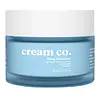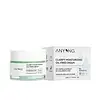What's inside
What's inside
 Key Ingredients
Key Ingredients

 Benefits
Benefits

 Concerns
Concerns

No concerns
 Ingredients Side-by-side
Ingredients Side-by-side

Water
Skin ConditioningGlycerin
HumectantSqualane
EmollientPropanediol
SolventXylitylglucoside
HumectantSaccharide Isomerate
HumectantBisabolol
MaskingPropylene Glycol Dibenzoate
Skin ConditioningIsostearyl Alcohol
EmollientPentylene Glycol
Skin ConditioningCaprylyl Glycol
EmollientAcrylates/C10-30 Alkyl Acrylate Crosspolymer
Emulsion StabilisingAnhydroxylitol
HumectantSodium Acrylates Copolymer
Beta-Glucan
Skin ConditioningCalendula Officinalis Flower Oil
MaskingXylitol
HumectantLecithin
EmollientSodium Hydroxide
BufferingEthylhexylglycerin
Skin ConditioningAvena Sativa Kernel Extract
AbrasiveCitric Acid
BufferingHumulus Lupulus Extract
AntimicrobialHydrolyzed Glycosaminoglycans
HumectantCeramide NP
Skin ConditioningSodium Hyaluronate
HumectantSodium Citrate
BufferingHydrolyzed Hyaluronic Acid
HumectantHyaluronic Acid
HumectantSodium Hyaluronate Crosspolymer
HumectantTerminalia Chebula Fruit Extract
Skin ConditioningWater, Glycerin, Squalane, Propanediol, Xylitylglucoside, Saccharide Isomerate, Bisabolol, Propylene Glycol Dibenzoate, Isostearyl Alcohol, Pentylene Glycol, Caprylyl Glycol, Acrylates/C10-30 Alkyl Acrylate Crosspolymer, Anhydroxylitol, Sodium Acrylates Copolymer, Beta-Glucan, Calendula Officinalis Flower Oil, Xylitol, Lecithin, Sodium Hydroxide, Ethylhexylglycerin, Avena Sativa Kernel Extract, Citric Acid, Humulus Lupulus Extract, Hydrolyzed Glycosaminoglycans, Ceramide NP, Sodium Hyaluronate, Sodium Citrate, Hydrolyzed Hyaluronic Acid, Hyaluronic Acid, Sodium Hyaluronate Crosspolymer, Terminalia Chebula Fruit Extract
Water
Skin ConditioningCentella Asiatica Leaf Extract
Skin ConditioningBacillus
Skin ConditioningNiacinamide
SmoothingSodium Hyaluronate
HumectantCapryloyl Salicylic Acid
ExfoliatingButylene Glycol
HumectantPropylene Glycol
HumectantAloe Barbadensis Leaf Juice
Skin ConditioningEctoin
Skin ConditioningGlycerin
HumectantSalix Alba Bark Extract
AstringentGinkgo Biloba Leaf Extract
Skin ConditioningInulin
Skin ConditioningFructose
HumectantAllantoin
Skin ConditioningMadecassic Acid
Skin ConditioningAsiaticoside
AntioxidantAsiatic Acid
Skin ConditioningPanthenol
Skin ConditioningSodium PCA
HumectantSorbitol
HumectantSpirulina Platensis Extract
Skin ProtectingPotassium Sorbate
PreservativeAcrylates/C10-30 Alkyl Acrylate Crosspolymer
Emulsion Stabilising1,2-Hexanediol
Skin ConditioningCaprylyl Glycol
EmollientPentylene Glycol
Skin ConditioningEthylhexylglycerin
Skin ConditioningWater, Centella Asiatica Leaf Extract, Bacillus, Niacinamide, Sodium Hyaluronate, Capryloyl Salicylic Acid, Butylene Glycol, Propylene Glycol, Aloe Barbadensis Leaf Juice, Ectoin, Glycerin, Salix Alba Bark Extract, Ginkgo Biloba Leaf Extract, Inulin, Fructose, Allantoin, Madecassic Acid, Asiaticoside, Asiatic Acid, Panthenol, Sodium PCA, Sorbitol, Spirulina Platensis Extract, Potassium Sorbate, Acrylates/C10-30 Alkyl Acrylate Crosspolymer, 1,2-Hexanediol, Caprylyl Glycol, Pentylene Glycol, Ethylhexylglycerin
 Reviews
Reviews

Ingredients Explained
These ingredients are found in both products.
Ingredients higher up in an ingredient list are typically present in a larger amount.
Acrylates/C10-30 Alkyl Acrylate Crosspolymer is a synthetic polymer. It is used to thicken and improve the texture of products. Due to its properties, it can prevent water and oil ingredients from separating.
Caprylyl Glycol is a humectant and emollient, meaning it attracts and preserves moisture.
It is a common ingredient in many products, especially those designed to hydrate skin. The primary benefits are retaining moisture, skin softening, and promoting a healthy skin barrier.
Though Caprylyl Glycol is an alcohol derived from fatty acids, it is not the kind that can dry out skin.
This ingredient is also used as a preservative to extend the life of products. It has slight antimicrobial properties.
Learn more about Caprylyl GlycolEthylhexylglycerin (we can't pronounce this either) is commonly used as a preservative and skin softener. It is derived from glyceryl.
You might see Ethylhexylglycerin often paired with other preservatives such as phenoxyethanol. Ethylhexylglycerin has been found to increase the effectiveness of these other preservatives.
Glycerin is already naturally found in your skin. It helps moisturize and protect your skin.
A study from 2016 found glycerin to be more effective as a humectant than AHAs and hyaluronic acid.
As a humectant, it helps the skin stay hydrated by pulling moisture to your skin. The low molecular weight of glycerin allows it to pull moisture into the deeper layers of your skin.
Hydrated skin improves your skin barrier; Your skin barrier helps protect against irritants and bacteria.
Glycerin has also been found to have antimicrobial and antiviral properties. Due to these properties, glycerin is often used in wound and burn treatments.
In cosmetics, glycerin is usually derived from plants such as soybean or palm. However, it can also be sourced from animals, such as tallow or animal fat.
This ingredient is organic, colorless, odorless, and non-toxic.
Glycerin is the name for this ingredient in American English. British English uses Glycerol/Glycerine.
Learn more about GlycerinPentylene glycol is typically used within a product to thicken it. It also adds a smooth, soft, and moisturizing feel to the product. It is naturally found in plants such as sugar beets.
The hydrophilic trait of Pentylene Glycol makes it a humectant. As a humectant, Pentylene Glycol helps draw moisture from the air to your skin. This can help keep your skin hydrated.
This property also makes Pentylene Glycol a great texture enhancer. It can also help thicken or stabilize a product.
Pentylene Glycol also acts as a mild preservative and helps to keep a product microbe-free.
Some people may experience mild eye and skin irritation from Pentylene Glycol. We always recommend speaking with a professional about using this ingredient in your routine.
Pentylene Glycol has a low molecular weight and is part of the 1,2-glycol family.
Learn more about Pentylene GlycolSodium Hyaluronate is hyaluronic acid's salt form. It is commonly derived from the sodium salt of hyaluronic acid.
Like hyaluronic acid, it is great at holding water and acts as a humectant. This makes it a great skin hydrating ingredient.
Sodium Hyaluronate is naturally occurring in our bodies and is mostly found in eye fluid and joints.
These are some other common types of Hyaluronic Acid:
Learn more about Sodium HyaluronateWater. It's the most common cosmetic ingredient of all. You'll usually see it at the top of ingredient lists, meaning that it makes up the largest part of the product.
So why is it so popular? Water most often acts as a solvent - this means that it helps dissolve other ingredients into the formulation.
You'll also recognize water as that liquid we all need to stay alive. If you see this, drink a glass of water. Stay hydrated!
Learn more about Water